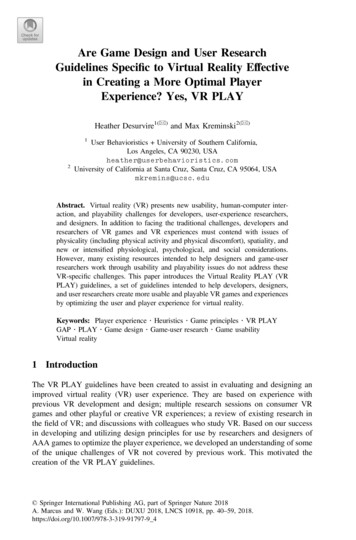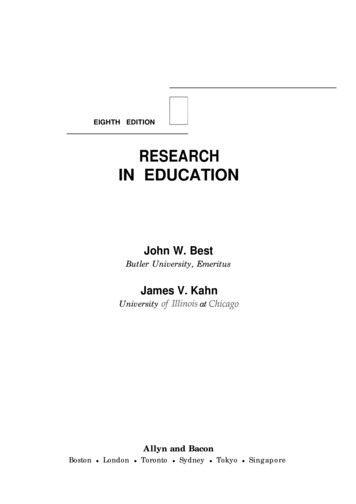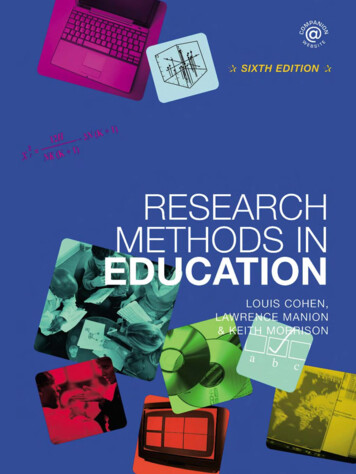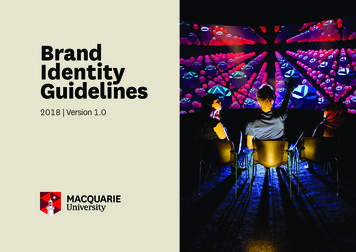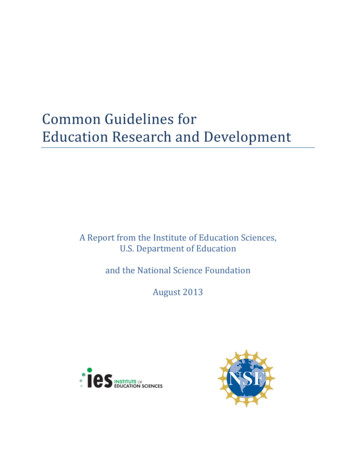
Transcription
Common Guidelines forEducation Research and DevelopmentA Report from the Institute of Education Sciences,U.S. Department of Educationand the National Science FoundationAugust 2013
ContentsTables . 3Preface. 4Members of the Joint Committee . 6Introduction . 7A Cross-Agency Project . 8Types of Research. 8Knowledge Generation and the Complex Connections among Research Types . 10Introduction to Tables . 11Conclusion . 24References Consulted by the Joint Committee . 25Appendix A: Illustrative Research Projects Funded by the Department of Education or the NationalScience Foundation. 27Examples of Research Types. 27Research Type: Foundational Research . 27Research Type: Early-Stage or Exploratory Research. 29Research Type: Design and Development . 31Crossing the Boundaries of Design and Development and Early Efficacy Research . 33Research Type: Efficacy Study. 35Research Type: Effectiveness Study . 39Research Type: Scale-up Study . 41Appendix B: Common Guidelines, by Research Type . 432
TablesTable 1: Purpose of Foundational, Early-Stage or Exploratory, and Design and DevelopmentResearch Studies . 12Table 2: Purpose of Studies that Assess the Impact of Education Interventions and Strategies . 14Table 3: Justification Guidelines . 16Table 4: Guidelines for Evidence to Be Produced by Studies . 19Table 5: Guidelines for External Feedback Plans . 23Table B- 1: Foundational Research . 43Table B- 2: Early-Stage or Exploratory Research . 45Table B- 3: Design and Development Research . 47Table B- 4: Impact Research . 493
PrefaceIn January 2011, a Joint Committee of representatives from the U.S. Department of Education (ED)and the U.S. National Science Foundation (NSF) began work to establish cross-agency guidelines forimproving the quality, coherence, and pace of knowledge development in science, technology,engineering and mathematics (STEM) education. The committee formed to enhance the efficiencyand effectiveness of both agencies’ STEM education research and development programs inresponse to recommendations from the Office of Science and Technology Policy (OSTP) andguidance from the Office of Management and Budget (OMB) (Zients, 2012). Although the startingplace for the committee was research in STEM, ED quickly realized the broader applicability of theguidelines to other content areas in which it funds research and development.Education research and development programs at NSF are distributed throughout its science andengineering directorates but are located primarily in its Directorate for Education and HumanResources (EHR). EHR’s purview includes K-12 education, postsecondary education, and afterschool and informal learning environments, as well as the study of science and engineeringinnovations that emerge from other directorates. ED’s research, development, and evaluationprograms are located primarily in the Institute of Education Sciences (IES) but also are representedin the Policy and Program Studies Service (PPSS), the Office of Innovation and Improvement (OII),and the National Institute on Disability and Rehabilitation Research (NIDRR).The Joint Committee examined whether the agencies’ expectations for the research studies theyfund could be characterized in such a way as to provide cross-agency guidance for program officers,prospective grantees, and peer reviewers. A first task was to define the types of ED- and NSFfunded research that relate to the development and testing of interventions and strategies designedto increase learning. Types of research range from early knowledge-generating projects to studiesof full-scale implementation of programs, policies, or practices. Importantly, the committee soughtto create a common vocabulary to describe the critical features of these study types to improvecommunication within and across the agencies and in the broader education research community.Second, the Joint Committee specified how the types of research relate to one another anddescribed the theoretical and empirical basis needed to justify each research type. The committeeemphasizes the importance of proposed studies building on and referencing an evidence base and,in turn, contributing to the accumulation of empirical evidence and development of theoreticalmodels. Throughout its work, the Joint Committee generally adhered to the guiding principlesidentified in Scientific Research in Education (National Research Council, 2002), which call forresearch that: poses significant questions that can be investigated empirically;links empirical research to relevant theory;uses research designs and methods that permit direct investigation of the question;is guided by a coherent and explicit chain of reasoning;replicates and generalizes across studies; andattends to contextual factors.Through this document, the Joint Committee seeks to provide a broad framework that clarifiesresearch types and provides basic guidance about the purpose, justification, design features, andexpected outcomes from various research types. In that spirit, the Joint Committee intends this tobe a “living document” that may be adapted by agencies or divisions within agencies in response to4
their needs and opportunities. Over time, the framework may be elaborated or rearrangedaccording to agency focus and assessments of the needs of education researchers and practitioners.The draft guidelines were distributed throughout ED and NSF for review and comment. NSF heldseveral sessions for agency staff to provide comments and feedback. The agencies jointly soughtfeedback from the research community at the 2013 annual meetings of the American EducationalResearch Association, where representatives from ED and NSF presented the guidelines and heldsmall discussion groups. ED and NSF representatives also presented the guidelines at a meeting ofFederal evaluators hosted by the Office of Management and Budget (OMB). Finally, NSF leadershipreviewed and commented on the document, and detailed reviews of the document by educationresearch experts were obtained through the Institute of Education Sciences’ Standards and ReviewOffice.5
Members of the Joint CommitteeJanice Earle, Co-ChairDirectorate for Education and Human Resources, National Science FoundationRebecca Maynard, Co-Chair (2011-2012)Ruth Curran Neild, Co-Chair (2012-2013)National Center for Education Evaluation and Regional Assistance, Institute of Education SciencesEx-OfficioJohn Q. Easton,Director, Institute of Education SciencesJoan Ferrini-MundyAssistant Director for Education and Human Resources, National Science FoundationElizabeth Albro, National Center for EducationResearch, Institute of Education SciencesJinfa Cai, Directorate for Education and HumanResources, National Science Foundation(2011-2012)Karen Cator, Office of Education Technology,Department of Education (2011-2012)Gavin Fulmer, Directorate for Education andHuman Resources, National Science Foundation(2011-2012)Edith Gummer, Directorate for Education andHuman Resources, National Science FoundationJim Hamos, Directorate for Education and HumanResources, National Science FoundationMichael Lach, Office of the Secretary,Department of EducationJoy Lesnick, National Center for EducationEvaluation and Regional Assistance,Institute of Education Sciences6Lynn Okagaki, National Center for EducationResearch, Institute of Education Sciences(2011-2012)Janet Kolodner, Directorate for Education andHuman Resources, National Science FoundationJefferson Pestronk, Office of Education Innovationand Improvement, Department of Education(2011-2012)Anne Ricciuti, Office of the Director,Institute of Education SciencesTracy Rimdzius, National Center for EducationEvaluation and Regional Assistance,Institute of Education SciencesAllen Ruby, National Center for EducationResearch, Institute of Education SciencesDeborah Speece, National Center for SpecialEducation Research, Institute of EducationSciencesSusan Winter, Social and Behavioral and EconomicSciences Directorate, National Science Foundation(2012)
IntroductionAt its core, scientific inquiry is the same in all fields. Scientific research, whether ineducation, physics, anthropology, molecular biology, or economics, is a continualprocess of rigorous reasoning supported by a dynamic interplay among methods,theories, and findings. It builds understanding in the form of models or theories thatcan be tested.Scientific Research in EducationNational Research Council, 2002Each year, the National Science Foundation (NSF) and the U.S. Department of Education (ED) makesubstantial investments in education research and development. Through these efforts, theagencies seek to improve opportunities to learn science, mathematics, engineering, and technology(STEM) and to increase student achievement, engagement and persistence in those areas. ED alsosupports research and evaluation in a range of areas other than STEM.Though complementary, the agencies’ focus areas in education research differ in ways thatcorrespond to their respective roles in government and society. NSF, which is charged withincreasing the quality and amount of science and engineering research in a variety of contexts, hasemphasized basic research on STEM learning, cognition, and development of instructionalapproaches, technologies, and materials in both formal and informal settings. In contrast, EDconcentrates its investments on developing and testing the effectiveness of well-defined curricula,programs, and practices that could be implemented by schools. The complementary missions of theagencies, along with the continuing urgency of improving American students’ STEM knowledge andskills, form the backdrop for the evidence guidelines and study types described in this document.This document describes NSF and ED’s shared understandings of the roles of various types or“genres” of research in generating evidence about strategies and interventions for increasingstudent learning. These research types range from studies that generate the most fundamentalunderstandings related to education and learning (for example, about brain activity), to researchthat examines associations between variables, iteratively designs and tests components of astrategy or intervention, or is designed to assess impact of a fully-developed intervention on aneducation-related outcome. More specifically, the document describes the agencies’ expectationsfor the purpose of each type of research, the empirical and/or theoretical justifications for differenttypes of studies, types of project outcomes, and quality of evidence.Fundamentally, these shared, cross-agency expectations are intended to (1) help organize andguide NSF’s and ED’s respective decisions about investments in education research and (2) clarifyfor potential grantees and peer reviewers the justifications for and evidence expected from eachtype of study, as well as relevant aspects of research design that would contribute to high-qualityevidence. The primary audiences for this document are agency personnel, scientific investigatorswho seek funding from these agencies for education research projects, and those who serve as peerreviewers of proposals for scientific research.By delineating common expectations for study characteristics, it is hoped that each agency will bebetter able to build on the investments of the other and to see its own investments reap greater7
return in improved and tested education practices and policy. And by clarifying the products thatshould result from different types of studies, the agencies hope to speed the pace of research anddevelopment in education—including obtaining meaningful findings and actionable results—through a more systematic development of knowledge (Shonkoff, 2012).For example, a project that involves design and development of an intervention or strategy should,at its conclusion, have generated a theory of action, a set of intervention components, andpreliminary evidence regarding promise for improving education outcomes. In combination, theseproducts from design and development research would make the case that an efficacy trial of astrategy or intervention is warranted, assuming positive and substantively important impacts (seeTable 3 for a full set of project outcomes). Without attention to each of these project outcomes,which serve as justification for potentially more-costly and wider-scale testing, the full evidentiarypotential of an investment in design and development may not be realized. Likewise, a wellconducted study of impacts should include hypothesis-generating exploratory analyses that caninform additional work. Research on implementation, adaptation, and adoption is an important partof all research endeavors.Ultimately, these expectations should advance knowledge by asking neither too little nor too muchof proposed studies. Too little can be asked of a study when it is not adequately justified or carefullydesigned to generate good evidence. Too much can be asked when the role of a particular kind ofstudy in evidence generation is unclear. For example, a project about design and development of anintervention should not be required to provide strong evidence of effectiveness among a widerange of populations. If an opportunity for such integration of research purposes occurs, it may beadvisable to pursue; however, it also is acceptable for a design and development project to stopshort of conducting an efficacy study.A Cross-Agency ProjectThis document resulted from collaborations between representatives from the National ScienceFoundation (NSF) and the U.S. Department of Education (ED) to identify the spectrum of studytypes that contribute to development and testing of interventions and strategies, and to specifyexpectations for the contributions of each type of study. This collaboration is but one example ofincreasing use of evidence government wide to support decision making about investments inprograms and research. Although NSF and ED focused on increasing knowledge related to learningin STEM, the general approach described in this document applies to knowledge generation in otherareas of education research.Types of ResearchMost simply, the six types of research described in this document form a “pipeline” of evidence thatbegins with basic and exploratory research, moves to design and development of interventions orstrategies, and, for interventions or strategies with initial promise, results in examination of theeffectiveness for improving learning or another related education outcome. However, as wedescribe later in this document, the reality of scientific investigation is more complicated, lessorderly, and less linear than such a “pipeline” suggests. In addition, these research types do notrepresent the entire panoply of useful investigations in education, nor does this document describethe full range of purposes for which a given type of research is useful.8
Below, we provide a basic description of the purpose of each of the six types of research. Theresearch types are described in more detail in Tables 1-4.Foundational Research and Early-Stage or Exploratory Research contributes to core knowledgein education. Core knowledge includes basic understandings of teaching and learning, such ascognition; components and processes involved in learning and instruction; the operation ofeducation systems; and models of systems and processes. Research Type #1: Foundational Research provides the fundamental knowledge that maycontribute to improved learning and other relevant education outcomes. Studies of this typeseek to test, develop, or refine theories of teaching or learning and may develop innovationsin methodologies and/or technologies that will influence and inform research anddevelopment in different contexts.Research Type #2: Early-Stage or Exploratory Research examines relationships amongimportant constructs in education and learning to establish logical connections that mayform the basis for future interventions or strategies to improve education outcomes. Theseconnections are usually correlational rather than causal.Design and Development Research (Research Type #3) develops solutions to achieve a goalrelated to education or learning, such as improving student engagement or mastery of a set ofskills. Research projects of this type draw on existing theory and evidence to design and iterativelydevelop interventions or strategies, including testing individual components to provide feedback inthe development process. These projects may include pilot tests of fully developed interventions todetermine whether they achieve their intended outcomes under various conditions. Results fromthese studies could lead to additional work to better understand the foundational theory behind theresults or could indicate that the intervention or strategy is sufficiently promising to warrant moreadvanced testing.Efficacy, Effectiveness, and Scale-up Research contributes to evidence of impact, generatingreliable estimates of the ability of a fully-developed intervention or strategy to achieve its intendedoutcomes. The three types of Impact Research share many similarities of approach, includingdesigns that eliminate or reduce bias arising from self-selection into treatment and controlconditions, clearly specified outcome measures, adequate statistical power to detect effects, anddata on implementation of the intervention or strategy and the counterfactual condition. However,these studies vary with regard to the conditions under which the intervention is implemented andthe populations to which the findings generalize. Specifically, 9Research Type #4: Efficacy Research allows for testing of a strategy or intervention under“ideal” circumstances, including with a higher level of support or developer involvementthan would be the case under normal circumstances. Efficacy Research studies may chooseto limit the investigation to a single population of interest.Research Type #5: Effectiveness Research examines effectiveness of a strategy orintervention under circumstances that would typically prevail in the target context. Theimportance of “typical” circumstances means that there should not be more substantialdeveloper support than in normal implementation, and there should not be substantialdeveloper involvement in the evaluation of the strategy or intervention.Research Type #6: Scale-up Research examines effectiveness in a wide range ofpopulations, contexts, and circumstances, without substantial developer involvement inimplementation or evaluation. As with Effectiveness Research, Scale-up Research should be
carried out with no more developer involvement than what would be expected undertypical implementation.For each of these research types, the Joint Committee has characterized the purpose, or how the type of research contributes to the evidence base (Tables 1 and 2);the theoretical and empirical justifications required for conducting this type of research(Table 3);expectations for research design and expected products of the research, such asexploratory analysis, impact estimates, or a well-elaborated theory of action (Table 4); andexpectations for review of the products from each type of research (Table 5).Knowledge Generation and the Complex Connections among Research TypesAlthough the six study types follow a logical sequence of development of basic knowledge, design,and testing, the Joint Committee emphasizes the reality of building knowledge is considerably morecomplex. Specifically, it assumes the following:Knowledge development is not linear. The current of understanding does not flow only in onedirection (that is, from basic research to studies of effectiveness). Rather, research generatesimportant feedback loops, with each type of research potentially contributing to an evidence basethat can inform and provide justification for other types of research. For example, just asFoundational Research can contribute to a justification for an Impact Research, so can the findingsfrom Impact Research identify needs for more fundamental exploration.Investigation can sometimes move directly from development of core knowledge to Scale-upResearch. New learning opportunities and technologies—Massive Open Online Courses (MOOCs),for example—make it possible to quickly test learning innovations at scale without prior smallscale testing.Individual studies may incorporate elements that cut across research types. For example, aDesign and Development Research project may incorporate a small-scale study to assess efficacy.Likewise, researchers conducting Efficacy Research may need to engage in design and developmentcycles, and studies of foundational theories of learning may incorporate both elements.The Joint Committee makes no assumption about the number of studies that will be conducted toaddress a given education research problem. Sometimes large numbers of Foundational, EarlyStage or Exploratory, or Design and Development studies may be required to develop a strategy orintervention that is ready for wider-scale examination of impact.10
Introduction to TablesThe following tables represent the various types of education research studies that were identified,along with how each type might address the following characteristics:1. Purpose of Foundational, Early-Stage or Exploratory, and Design and DevelopmentResearch Studies2. Purpose of Studies that Assess the Impact of Education Interventions and Strategies3. Justification Guidelines4. Guidelines for Evidence to Be Produced by Studies5. Guidelines for External Feedback PlansIn Appendix B, the same information is presented in a different format. Appendix B containsinformation organized by type rather than characteristics.11
Table 1: Purpose of Foundational, Early-Stage or Exploratory, and Design andDevelopment Research StudiesFoundational, Early-Stage or Exploratory, and Design and Development StudiesAn important genre of education research advances knowledge about fundamental principles ofsound education practice. This includes studies to advance foundational knowledge that guidestheory development; Early-Stage or Exploratory research to identify evidence of the promise (orlack thereof) of programs, policies or practices; and research that guides the development andearly-stage testing of innovative programs, policies and practices to improve education outcomes.Foundational ResearchEarly-Stage orExploratory ResearchThe purpose of Foundational Research is to advance the frontiers ofeducation and learning; develop and refine theory and methodology;and provide fundamental knowledge about teaching and/or learning.Foundational Research studies may examine phenomena withoutestablishing an explicit link to education outcomes.The purpose of Early-Stage or Exploratory Research is to investigateapproaches to education problems to establish the basis for designand development of new interventions or strategies, and/or to provideevidence for whether an established intervention or strategy is readyto be tested in an efficacy study.Early-Stage or Exploratory Research should establish initialconnections to outcomes of interest. Studies in this genre shouldsupport the development of a well-explicated theory of action that caninform the development, modification, or evaluation of an interventionor strategy. They should build on existing research and theory toexamine issues such as:Design andDevelopment Research12(1) Associations between (a) education or learning outcomes and (b)malleable factors (that is, factors that are alterable, such as children’sbehaviors; technologies; education programs, policies, and practices)and; (2) Factors and conditions that may mediate or moderate therelationship between (a) education or learning outcomes and (b)malleable factors; and (3) Opportunities for new interventions orstrategies, and challenges to their adoption, with the goal of informingpolicy, practice, and future design or development.The purpose of Design and Development Research is to develop newor improved interventions or strategies to achieve well-specifiedlearning goals or objectives, including making refinements on the basisof small-scale testing. Typically this research involves fourcomponents:(1) Development of a solution (for example, an instructional approach;design and learning objects, such as museum exhibits or media; oreducation policy) based on a well-specified theory of actionappropriate to a well-defined end user; (2) Creation of measures to
assess the implementation of the solution(s); (3) Collection of data onthe feasibility of implementing the solution(s) in typical deliverysettings by intended users; and (4) Conducting a pilot study toexamine the promise of generating the intended outcomes.In some cases, funders will expect all four stages to be completedwithin a single project; in other cases, Design and DevelopmentProjects may entail sequential projects.13
Table 2: Purpose of Studies that Assess the Impact of Education Interventionsand StrategiesStudies of ImpactThe purpose of Impact Studies is to generate reliable estimates of the ability of a fully developedintervention or strategy to achieve its intended outcomes. For an impact study to be warranted, thetheory of action must be well established and the components of the intervention or strategy wellspecified.The three types of impact studies—Efficacy, Effectiveness, and Scale-up—differ with regard to theconditions under which the intervention is implemented and the populations to which the findingsgeneralize. In addition, as the research moves from Efficacy to Scale-up, studies should also givegreater attention to identifying variation among impacts by subgroup, setting, level ofimplementation, and other mediators.For all impact studies, descriptive and exploratory analyses should be sufficiently elaborated todetermine the extent to which the findings support the underlying theory of action.Efficacy ResearchEffectiveness ResearchScale-up Research14The purpose of Efficacy Research is to determine whether anintervention or strategy can improve outcomes under what aresometimes called “ideal” conditions. For example, these conditionsmay include more implementation support or more highly trainedpersonnel than would be expected under routine practice, or incontexts that include a more homogeneous sample of students,teachers, schools, and/or districts than is typical.Efficacy studies may involve the developer in the implement
Scientific Research in Education . National Research Council, 2002 . Each year, the National Science Foundation (NSF) and the U.S. Department of Education (ED) make substantial investments in education resea




